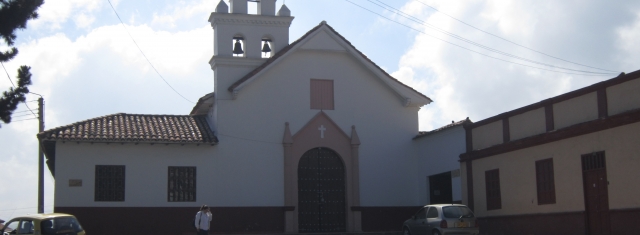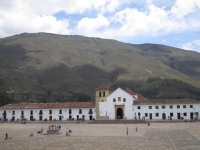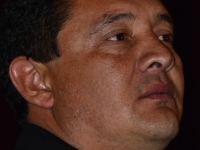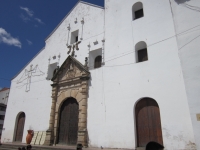Arts
In the middle of Colombia
Find more than 50 doctrinaire temples

San Laureano chapel, Tunja. Boyaca, Colombia (Source: Helena Sanchez, colombian journalist)
USPA NEWS -
According to the Colombian researcher Henry Neiza, nowadays Boyacá has 54 doctrinaire temples documented, some of them destroyed and some others with their architectural characteristics completely changed, due to political decisions based on the “need“ to modernize those structures.
Doctrinare temples, dated from 1560, had their origin on a colonial policy of reduction which consisted on founding towns adding the small ones located nearby, so that Spaniards could facilitate both main principles of colonization: convertion of indigenous people to catholic faith, and recollection of tributes.
In 1560 colonizers who lived in Boyacá regulated the instructions for building these temples, which had particular and specific elements to be erected: a chapel, an arcade, the portico, chapels, an enormous portico´s cross and a small house for the priest.
In 1560 colonizers who lived in Boyacá regulated the instructions for building these temples, which had particular and specific elements to be erected: a chapel, an arcade, the portico, chapels, an enormous portico´s cross and a small house for the priest.
Doctrinaire temples which were documented by Neiza are located in the following municipalities: Betéitiva, Boyacá, Busbanzá, Cerinza, Chámeza ““actualmente Belencito-, Chíquiza, Chitagoto (this is the original name of the municipality of Paz del Río), Chivatá, Ciénega, Cucaita, Cuítiva, Gachantivá, Icabuco, Iguaque, Iza, La Salina, Maripí, Monguí, Monquirá ““nearby Villa de Leyva, an important touristic center-, Morcote, Motavita, Oicatá, Otengá, Panqueba, Paya, Pisba, Ramiriquí, Sáchica, Samacá, San Mateo, Sátiva, Siachoque, Socha Viejo, Sogamoso, Somondoco, Sora, Soracá, Sotaquirá, Susacón, Sutamarchán, Sutatenza, Tasco, Tibasosa, Tinjacá, Tobasía, Toca, Tota, Turmequé, Tuta y Tutazá. Likewise are included Doctrinaire Temple of las Mercedes (the place where Chiscas municipality was originally founded), and missing Yuca, a small town that was added to Sutamarchán municipality.
Behind the research project
Henry Neiza has affirmed that the objective of this research project “it is not restoring ruins or inventing missing elements, but protecting what we still have very abandoned and nobody seems to be interested on“. However, he points out that Colombian Cultural Ministry, based on his discoveries has proposed including a collection of doctrinaire temples located in Boyacá in the World Heritage Site.
Neiza also wonders about the number of troubles that would arise among the experts involved in restoring processes, because it would imply incorporating modern materials which directly change this inheritance. For instance, it is necessary contemplate seism-resistance criteria that uses new generation materials to allow structural firmness and guarantee its permanence on time.
The researcher also emphasizes on the importance of primary sources in their findings. Neiza started looking for information since he was 12 years when he felt curious because he found his hometown temple ““located in Cucaita municipality- in the Colombian Art Encyclopedia; then, he kept researching in high school, and he spots around 20 temples in Boyacá, which were mentioned in some writing pieces of colonial art written by Ph.D Antonio Martínez Zulaica.
Afterwards, his thesis project in the university referred to the similarities of five doctrinaire temples in Boyacá, and he found out specific instructions for building these temples ““such as data, place of construction, making of ecclesiastical furnishings, etc.- in the Archivo General the Indias, which is and archive in Seville storing documents related to the administration of Spain´s colonial empire.
Even though Neiza assures that there are some local majors interested in protecting doctrinaire temples, there is another problem: temples are private property, because they depend on Catholic Church, and Colombian state cannot invest public means in this kind of properties.
Even though Neiza assures that there are some local majors interested in protecting doctrinaire temples, there is another problem: temples are private property, because they depend on Catholic Church, and Colombian state cannot invest public means in this kind of properties.
The only one way the state could invest money is converting temples to world heritage sites, so that it would come true the protection of this unique historical richness for humanity, which is located in one of the most amazing places around the world and that has hidden treasures for everyone: Boyacá, a colombian state located in the middle of this rich country.
Liability for this article lies with the author, who also holds the copyright. Editorial content from USPA may be quoted on other websites as long as the quote comprises no more than 5% of the entire text, is marked as such and the source is named (via hyperlink).








